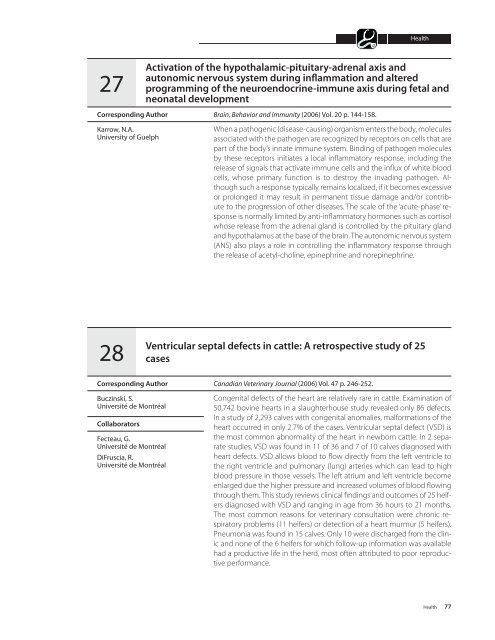A52-75-2007E.pdf - AgroMedia International Inc
A52-75-2007E.pdf - AgroMedia International Inc
A52-75-2007E.pdf - AgroMedia International Inc
Create successful ePaper yourself
Turn your PDF publications into a flip-book with our unique Google optimized e-Paper software.
Health27Activation of the hypothalamic-pituitary-adrenal axis andautonomic nervous system during inflammation and alteredprogramming of the neuroendocrine-immune axis during fetal andneonatal developmentCorresponding AuthorKarrow, N.A.University of GuelphBrain, Behavior and Immunity (2006) Vol. 20 p. 144-158.When a pathogenic (disease-causing) organism enters the body, moleculesassociated with the pathogen are recognized by receptors on cells that arepart of the body’s innate immune system. Binding of pathogen moleculesby these receptors initiates a local inflammatory response, including therelease of signals that activate immune cells and the influx of white bloodcells, whose primary function is to destroy the invading pathogen. Althoughsuch a response typically remains localized, if it becomes excessiveor prolonged it may result in permanent tissue damage and/or contributeto the progression of other diseases. The scale of the ‘acute-phase’ responseis normally limited by anti-inflammatory hormones such as cortisolwhose release from the adrenal gland is controlled by the pituitary glandand hypothalamus at the base of the brain. The autonomic nervous system(ANS) also plays a role in controlling the inflammatory response throughthe release of acetyl-choline, epinephrine and norepinephrine.28Ventricular septal defects in cattle: A retrospective study of 25casesCorresponding AuthorBuczinski, S.Université de MontréalCollaboratorsFecteau, G.Université de MontréalDiFruscia, R.Université de MontréalCanadian Veterinary Journal (2006) Vol. 47 p. 246-252.Congenital defects of the heart are relatively rare in cattle. Examination of50,742 bovine hearts in a slaughterhouse study revealed only 86 defects.In a study of 2,293 calves with congenital anomalies, malformations of theheart occurred in only 2.7% of the cases. Ventricular septal defect (VSD) isthe most common abnormality of the heart in newborn cattle. In 2 separatestudies, VSD was found in 11 of 36 and 7 of 10 calves diagnosed withheart defects. VSD allows blood to flow directly from the left ventricle tothe right ventricle and pulmonary (lung) arteries which can lead to highblood pressure in those vessels. The left atrium and left ventricle becomeenlarged due the higher pressure and increased volumes of blood flowingthrough them. This study reviews clinical findings and outcomes of 25 heifersdiagnosed with VSD and ranging in age from 36 hours to 21 months.The most common reasons for veterinary consultation were chronic respiratoryproblems (11 heifers) or detection of a heart murmur (5 heifers).Pneumonia was found in 15 calves. Only 10 were discharged from the clinicand none of the 6 heifers for which follow-up information was availablehad a productive life in the herd, most often attributed to poor reproductiveperformance.Health 77





